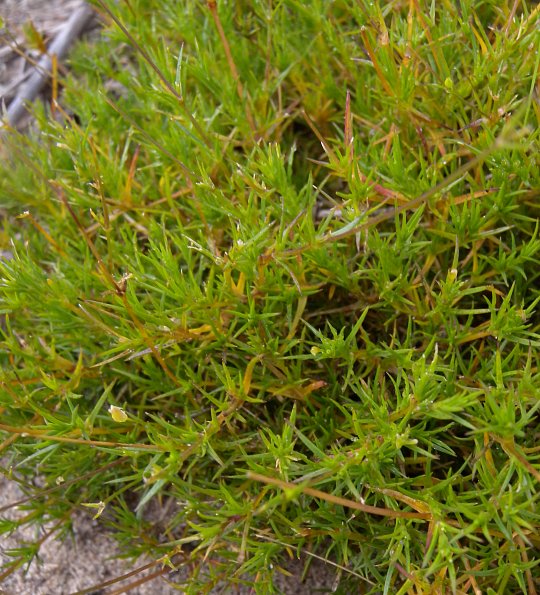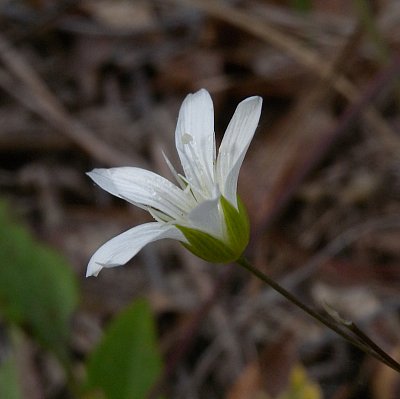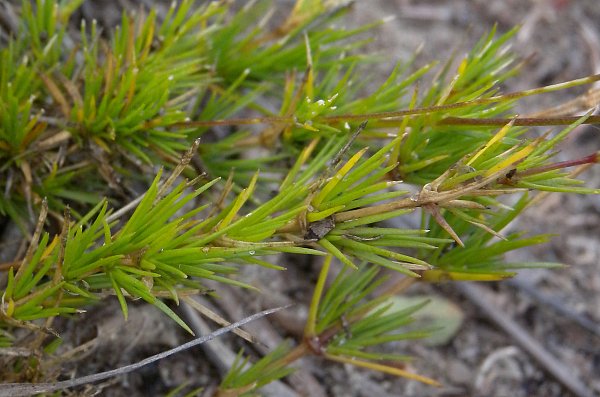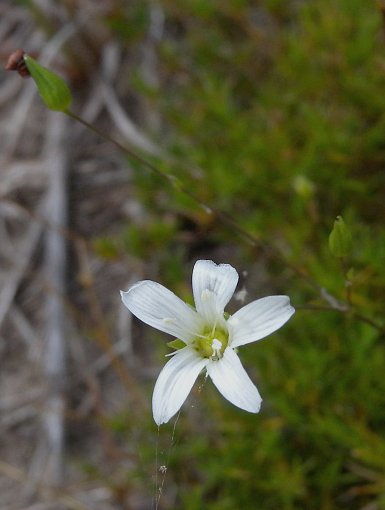
Individual leaves are ½–¾" long and up to 2 mm. across; they are linear to narrowly linear-lanceolate in shape, while their margins are entire. The leaf bases are narrowly connate, enclosing the adjacent stems, while the leaf tips taper gradually into needle-like points. The leaves are yellowish green to medium green, glabrous, and stiff; their upper surfaces are flat, while their lower surfaces are increasingly convex toward their bases. Many stems terminate in large airy cymes of 5-50 flowers; these cymes are dichotomously or trichotomously branched. The branches of each cyme are slender, and glabrous; solitary flowers are borne on slender glabrous pedicels up to 2" long.

Each flower spans about 1/3" (8 mm.) across when it is fully open, consisting of 5 white spreading petals, 5 green sepals, 10 stamens with white filaments and white anthers, and a light green ovary with 3 white styles. The petals are oblong to oblanceolate in shape with either rounded or slightly notched tips; they are longer than the sepals. The sepals are 4-5 mm. long, lanceolate in shape with acute tips, and 3-5 veined. The blooming period occurs from late spring to mid-summer, lasting about 1-2 months. Afterwards, the flowers are replaced by ovoid seed capsules about 3-4 mm. tall. These capsules open up at their apices, where they are 3-toothed, releasing numerous tiny seeds. The seeds are about 1 mm. long, compressed-reniform in shape, dark brown to black, and minutely tubercled. The root system consists of a taproot or thickened crown with fibrous roots.

Cultivation: The preference is full sun, dry conditions, and calcareous soil containing and abundance of sand, gravel, or rocky material. Partial shade is also tolerated. This plant is a potential candidate for rock gardens, although it is difficult to transplant. Competition from taller and more aggressive plants is not tolerated.
Range & Habitat: The native Stiff Sandwort is found primarily in northern Illinois, where it is uncommon (see Distribution Map). As a result of development and habitat destruction, populations of this plant have declined. Habitats include sandy open woodlands, dry sandy savannas, dry sand prairies, dry gravel prairies, hill prairies, limestone glades, ledges along cliffs, exposed slopes of bluffs, sandy ridges along Lake Michigan, and low sand dunes along Lake Michigan. This plant is found in high quality natural areas where there is sparse ground vegetation.

Faunal Associations: Little information is available about floral-faunal relationships for this plant. The flowers probably attract small bees and flies.
Photographic Location: A sandy savanna and low sand dune along Lake Michigan at the Illinois Beach State Park in NE Illinois.

Comments: Because of the mats of stiff prickly foliage, this is a very distinctive plant. Stiff Sandwort (Minuartia michauxii) is similar in appearance to a closely related plant, Slender Sandwort (Minuartia patula). The latter plant usually has opposite leaves that are spaced more evenly along its stems and fascicled secondary leaves are either absent or poorly developed. In addition, the leaves of this latter plant are more succulent and terete than those of Stiff Sandwort. Slender Sandwort is typically found in wooded areas, rather than the open and exposed locations that Stiff Sandwort prefers. Other similar species in the Pink family (Caryophyllaceae) have either wider or shorter leaves, their opened seed capsules have more than 3 teeth at their apices, or their flowers are smaller in size and less showy. Two scientific synonyms of Stiff Sandwort are Minuartia stricta and Arenaria stricta. Other common names of this plant include Rock Sandwort and Michaux's Stitchwort.